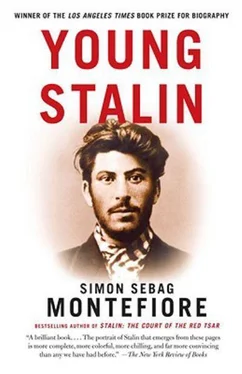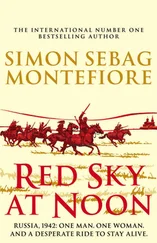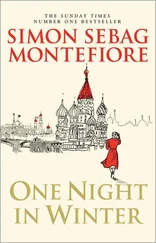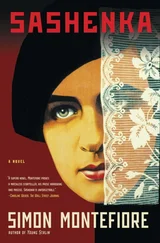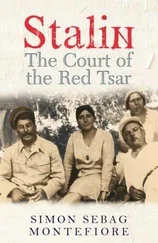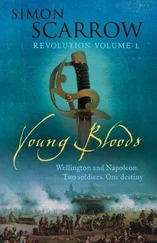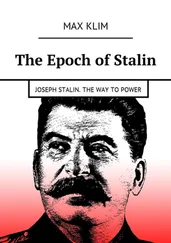The observatory still stands, though it is as rundown as every institution in Georgia. Stalin’s room remains, with a few of his supposed possessions and the old plaque: THE GREAT STALIN—LEADER OF VKPB AND WORLD PROLETARIAT—LIVED AND WORKED HERE, THE TIFLIS METEOROLOGICAL OBSERVATORY, FROM 28 DECEMBER 1899 TO 21 MARCH 1901, LEADING ILLEGAL SOCIAL-DEMOCRATIC WORKERS’ CIRCLES.
In Russia, the mercantile and middle classes, who had no access to political power, often sympathized with the revolutionaries, but in Georgia they could also count on local patriotism—and a web of family clans reaching the highest nobility. The Shervashidzes managed to be top Petersburg courtiers while on their Abkhazian estates enjoying links to the revolutionaries. Prince Giorgi Shervashidze was Chancellor of the Court of the Dowager Empress Maria Fyodorovna, Alexander III’s widow and Nicholas II’s mother. After the Revolution and until the 1930s, the Shervashidzes who remained in the USSR were protected by the local Bolshevik leader and Stalin courtier Nestor Lakoba.
The most important Russian revolutionary in Georgia then was tall, stooped, balding Victor Kurnatovsky, who had shared Lenin’s Siberian exile and even met Plekhanov in Zurich. Many of the most active revolutionaries were not Caucasians but Russians. In the railway depot, Sergei Alliluyev was assisted by the affable, ginger-bearded Mikhail Kalinin, another railway worker of peasant origins whom Soso was to meet now: he would be Stalin’s long-serving head of state. The other leaders were Georgians—Jordania, Jibladze, Mikha Tskhakaya and Philip Makharadze, all founders of the Third Group back in 1892.
Going underground meant that Stalin also avoided conscription into the army in 1901. On his last arrest in 1913, he told the police he had been “exempted from conscription for family reasons in 1901.” The Gori police officer Davrichewy helped provide the paperwork enabling him to escape military service, according to his son’s memoirs, possibly by citing Stalin’s family problems and also moving his birthday a year later to 21 December 1879. Stalin was not bothered by conscription again until 1916.
When Interior Minister Plehve was assassinated in 1904, his police director, Lopukhin, found forty of his own private letters in the dead man’s safe: the Minister was perlustrating his own chief of police.
During the 1880s, Colonel G. P. Sudeikin of the Petersburg Okhrana cultivated a young People’s Will terrorist named Degaev, a success that allowed the policeman to become “the master of revolution in Russia.” But this had a price: the Colonel was even forced to order murders to conceal his double-agent. Then in 1883 Degaev lured him to a meeting and murdered him. Degaev ultimately disappeared. Years later, a mathematics professor in an obscure U.S. midwestern university was exposed as none other than Degaev, a story finely told in Richard Pipes’s Degaev Affair . Such tactics are always a deadly gamble. In our times, the U.S. intelligence officers who set up the Afghan mujahideen to fight the Soviets and the Israeli intelligence officers who sponsored Islamic radicals on the West Bank to counteract the PLO learned similar lessons when their organizations developed into the Jihadist al-Qaeda and Hamas, respectively.
The Okhrana could not afford to ignore the ingenuity of the SR assassins. In a foreshadowing of al-Qaeda and 9/11, the success of aeroplane flight suggested these new machines as weapons. SR terrorists considered flying a dynamite-packed biplane into the Winter Palace, so the Okhrana in 1909 ordered the monitoring of all flights as well as people learning to fly and members of aero-clubs. It is a mark of the Okhrana’s excellence that in 1909 it was imaginative enough to envisage a crime that was beyond the scope of the FBI and CIA in the twenty-first century.
The dates of these memoirs are always important. In memoirs dictated in 1936, Vadachkoria implies that it was Stalin who ordered the murder, a naïve thing to record that year; an unthinkable thing to record a year later during the Great Terror, or afterwards. The story of Stalin just suspecting the police spy and being right about it was published as part of the cult of personality. The story of the sleuth being killed appears only in the archival original and is published here for the first time.
Kandelaki, in memoirs recorded in 1935, before the Terror, strongly implies that Stalin was the Rothschilds arsonist. The Stalinist histories, which quote Kandelaki, suppress any suggestion that the Leader had been an arsonist, killer, bank robber or seducer. Kandelaki’s record is published here for the first time. Historians have often mistaken him for David Kandelaki, a young trade official in the 1930s whom Stalin used as his secret emissary to open negotiations with Hitler, a probe three years before the 1939 Molotov-Ribbentrop Pact. Stalin had David Kandelaki shot in 1937. But the latter was not Constantine—or Kotsia—Kandelaki of Batumi, later a Menshevik and Minister of Finance in the independent Georgian Democratic Republic of 1918–21.
This would have irritated Stalin—the sort of personal detail that more sophisticated interviewees in the 1930s left out of their memoirs. Natasha Kirtava recorded two sets of memoirs, one in 1934 and the other in 1937. Needless to say, the unpublished kissing episode appeared only in the first, before the Terror.
The Batumi demonstration and the Smirba story became seminal Stalinist legends. When the boss of Abkhazia, one of Stalin’s favourite courtiers, Nestor Lakoba, wrote his Stalin i Hashimi (Stalin and Hashimi) in 1934, he reinforced the cult of personality which had begun in 1929. Stalin’s secretary Ivan Tovstukha worried about the text, writing to Stalin’s then deputy Lazar Kaganovich, “Had the Hashimi text… Still things to correct and rewrite… What to do? Should it be thrown out?” It was not. Its publication won Lakoba favour but not for long. A year later, his work was outstripped by the massive exaggeration of History of the Bolshevik Organization in the Caucasus by Beria. Stalin himself, according to Beria’s son, amended the manuscript, “striking out names and replacing them with his own.” A huge volume called The Batumi Demonstration 1902 followed in 1937. Beria swiftly moved to destroy his rival Lakoba, poisoning him and then murdering and personally torturing his wife and children. See Stalin: The Court of the Red Tsar for the full story. As for Hashimi Smirba himself, he moved house in 1916, burying the printing-press in his garden. He died in 1922 aged eighty-one. In his seventies, Stalin chuckled about Smirba. He knew Lakoba’s book was widely regarded as propaganda. After all, it claimed that Stalin was “the greatest man of a whole epoch, such as history gives to humanity only once in one or two hundred years.” But Stalin insisted, “It’s true as it was told in that book—that’s really how it happened.”
In early 1939, the Moscow Arts Theatre commissioned the brilliant but under-employed writer Mikhail Bulgakov to write a romantic play about young Stalin in Batumi to celebrate the dictator’s sixtieth birthday that December. Stalin must have signed off on the commission. He admired Bulgakov—like Chekhov, a practising doctor-turned-writer—particularly for his novel The White Guard . Its dramatized version The Days of the Turbins was Stalin’s favourite play: he saw it fifteen times. Yet, as with Pasternak and Shostakovich, Stalin played a game of cat-and-mouse, personally phoning Bulgakov to assure him he would be given work, then tightening the screws on him again. Bulgakov, like Pasternak, was fascinated by his omnipotent persecutor and had toyed with the idea of this play since 1936, even though he knew “it’s dangerous for me.” Basing the play on the book The Batumi Demonstration 1902 and presumably on conversations with witnesses, Bulgakov finished a draft in June 1939, first calling it The Priest , Stalin’s nickname among the workers, then It Happened in Batumi , then just Batumi . The romantic play contains no love affairs but it implies Stalin’s relationship with Natalia Kirtava, for his companion in the play is a Natasha, who is jointly based on Kirtava and Lomdzharia’s sister. The cultural apparatchiks liked and approved the play. In August, Bulgakov, declaring that he wanted to interview witnesses and read the archives, set off by train for Batumi with his wife, Elena. But Stalin did not wish his status as statesman (he was just about to sign the Molotov-Ribbentrop Pact with Hitler) undermined by any revelations contained in these archives, many of which have been used in this book. The Bulgakovs were recalled by telegram: “Journey no longer necessary. Return to Moscow.” Bulgakov fell ill. Stalin read the play. Visiting the Arts Theatre, he told the director that Batumi was a good piece but could not be staged, adding (hypocritically), “All young people are the same, so why write a play about the young Stalin?” The play was hackwork for Bulgakov, who secretly finished his anti-Stalin masterpiece The Master and Margarita before his death in 1940.
Читать дальше
